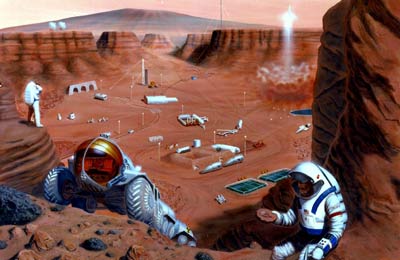The top three reasons for humans in spaceby Michael Huang
|
| In response to the question “Humans or robots in space?”, the answer is “Both”. |
Work in space is becoming as diverse as work on Earth. Some people work for government agencies; some run their own businesses. Some advance the boundaries of knowledge; some push the limits of technology. Although these contributions matter, the most important aspect of humans in space is not their work at all.
To live
On Earth, we know intuitively that life is more important than non-life, that an animal is more important than a rock. However, this applies to the rest of the universe as well. Out of all the colossal and wondrous structures of the universe—galaxies, stars, planets—the most important parts of the universe are the parts that are alive. (The second most important parts are the non-living objects that support life, e.g., the sun.)
This view of the cosmos was elegantly described by the mathematician and philosopher Frank Ramsey (as quoted by Cambridge cosmologist Sir Martin Rees in Our Final Hour): “I don’t feel the least humble before the vastness of the heavens. The stars may be large, but they cannot think or love; and these are qualities which impress me far more than size does… My picture of the world is drawn in perspective, and not like a model drawn to scale. The foreground is occupied by human beings, and the stars are all as small as threepenny bits.”
The ultimate aim of human spaceflight is “to extend life to there”, to use the phrase from NASA’s vision statement, to establish habitats beyond Earth. Although life on Earth is diverse and long-standing, it has been restricted to this planet and has failed to go any further. Humans can bring life to the rest of the solar system and beyond. This task is known as “colonization” or “settlement”. The efforts of astronauts and cosmonauts since 1961 are just the beginning of this process.
One could agree with all of the above, but ask why this should be a priority for this generation. Why do it now?
To survive
Humankind made it through the 20th century relatively well, but there were close calls: the Cuban Missile Crisis almost began a total war between nuclear-armed superpowers. The 21st century has presented its own distinct challenges. Nuclear and biological weapon technologies are spreading to many nations and groups. Progress in science and technology, while advancing humankind, will also lead to the development of more destructive weapons and possibly other unintended consequences. In addition to these manmade threats, natural threats such as epidemics and impacts from space will continue to be with us.
| The most valuable part of the universe is life: not only because life is important, but because life appears to be extremely rare. |
The old saying, “Don’t put all your eggs in one basket”, advises that valuable things should be kept in separate places, in case something bad happens at one of the places. This advice is more familiar to investors in the guise of “diversify your portfolio” and “spread your risk”: one should invest in many different areas in case one area declines disastrously.
The same principle applies to the big picture. The most valuable part of the universe is life: not only because life is important, but because life appears to be extremely rare. Life and humankind are presently confined to the Earth (although we have built habitats in Earth orbit and ventured as far as the moon). If we were throughout the solar system, at multiple locations, a disaster at one location would not end everything. If we had the technologies to live in the extreme environments beyond Earth, we would be able to live through the extreme environments of disaster areas and other regions of hardship.
Many agree that it’s time for colonization. “The goal of the human spaceflight program should be to increase our survival prospects by colonizing space,” wrote Princeton astrophysicist J. Richard Gott in Time Travel in Einstein’s Universe. “If we were up there among the planets, if there were self-sufficient human communities on many worlds, our species would be insulated from catastrophe,” wrote Cornell space scientist Carl Sagan in Pale Blue Dot.
Colonization is not guaranteed. Human spaceflight is not guaranteed. They are the results of choices made by individuals in political offices, in government agencies, in boardrooms, in offices and in homes. These choices will influence this generation, but more crucially they will determine the lives of a great many generations to come:
“The theme of this book is that humanity is more at risk than at any earlier phase in its history. The wider cosmos has a potential future that could even be infinite. But will these vast expanses of time be filled with life, or as empty as the Earth’s first sterile seas? The choice may depend on us, this century.”
— Cambridge cosmologist Sir Martin Rees, Our Final Hour
